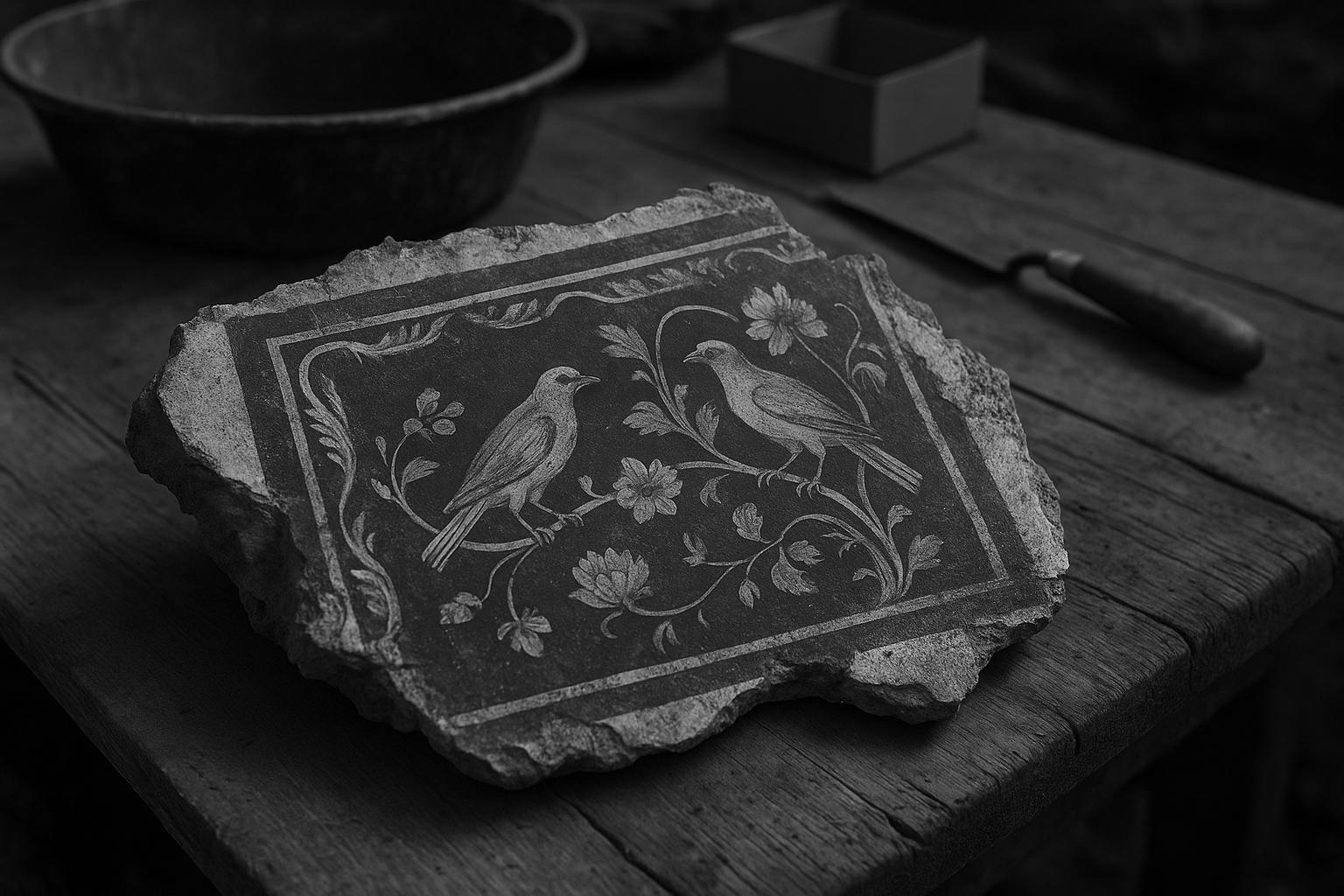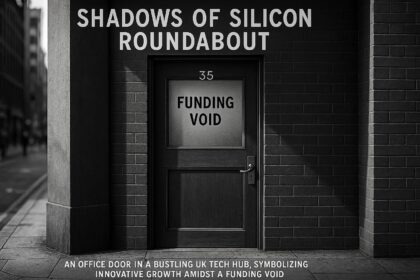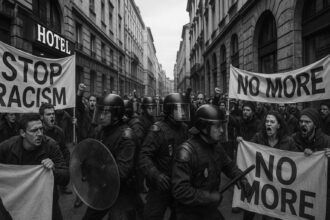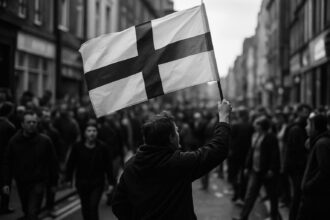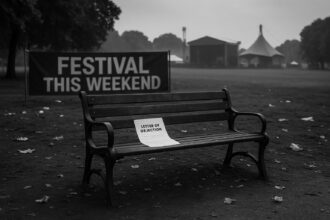A trove of vivid Roman fresco fragments uncovered in Southwark offers new insights into the opulence and cultural sophistication of a wealthy London suburb 2,000 years ago, highlighting its status as a cosmopolitan hub within the empire.
Archaeologists in London have uncovered a remarkable collection of Roman fresco fragments that paint a vivid picture of life in a wealthy Southwark villa some 2,000 years ago. The discovery was made during redevelopment work in 2021 in an area often nicknamed the “Beverly Hills of Roman London” due to its affluent status in ancient times. The sheer scale and quality of the frescoes, painstakingly reconstructed by experts at the Museum of London Archaeology, highlight the opulence and cultural sophistication of this suburban enclave during the Roman period.
The frescoes, spread over approximately 20 walls, feature intricate and colourful depictions of birds, fruits, flowers, musical lyres, and decorative panels. Notably, the artwork includes rare yellow motifs seldom seen in Roman Britain, hinting at artistic influences that traversed the empire. Among the thousands of plaster fragments, a Latin inscription bearing the word “Fecit”—meaning “has made this”—was found on a carved decorative tablet known as a tabula ansata. This signature suggests the involvement of identified artists, though the name itself remains lost due to missing fragments. Additionally, faint graffiti using the Greek alphabet—a unique find in Britain—was uncovered, suggesting the villa may have had a commercial role, potentially linked to trade or storage within the bustling city.
This find complements other significant Roman discoveries around London that illuminate the city’s prominence in Roman Britain between the late 1st century and early 2nd century AD. Archaeologists at the Museum of London have also revealed exceptionally large Roman mosaics and a rare mausoleum in Southwark, believed to be a burial site for wealthy Romans, underscoring the area’s high social status well beyond residential wealth. Similarly, recent excavation beneath an office block unearthed London’s first Roman basilica, a public building at the heart of the city’s political and economic life after the Romans re-established control following the Boudiccan revolt.
Moreover, the freshly confirmed route of Watling Street—the Roman road that facilitated trade and movement after the invasion of AD 43—adds further context to this network of commercial and residential wealth in Southwark. Such infrastructure investments reflect the rapid urban growth and strategic importance of London as a provincial capital within the wider Roman Empire.
Experts see the Southwark frescoes as more than just decorative art; they are tangible proof of a thriving, cosmopolitan population in early Roman London. Everyday traces such as painter’s guidelines and graffiti depicting human emotions reveal glimpses into the lives and creativity of its ancient inhabitants. According to a senior MOLA archaeologist, this affluent suburb’s cultural richness was unparalleled in Roman Britain, confirming London’s crucial role within the empire and its readiness to embrace diverse artistic traditions from across Europe.
With analysis ongoing, archaeologists remain hopeful that additional fresco fragments will emerge, possibly completing the signature and shedding light on the identities of the talented artists whose work has survived millennia. This discovery enriches the historical narrative of Roman Britain, highlighting a sophisticated urban society investing heavily in its infrastructure and artistic expression.
 Reference Map:
Reference Map:
- Paragraph 1 – [1]
- Paragraph 2 – [1]
- Paragraph 3 – [1], [3], [4]
- Paragraph 4 – [1], [5], [6], [7]
- Paragraph 5 – [1]
- Paragraph 6 – [1]
Source: Noah Wire Services
- https://archaeologymag.com/2025/06/roman-wall-paintings-found-in-southwark-london/ – Please view link – unable to able to access data
- https://www.mola.org.uk/discoveries/news/discovery-ornate-roman-fresco-revealed – Archaeologists from the Museum of London Archaeology (MOLA) have uncovered an ornate Roman fresco at 21 Lime Street, London. Dating to the late 1st century AD, the fresco was discovered six metres below street level during archaeological fieldwork for a new office development. The fragile remains, surviving to a width of nearly 2.5 metres and a height of over 1.5 metres, were carefully removed from the site by MOLA’s archaeological conservators. The fresco was deliberately toppled and the Forum immediately built over it, preserving the artwork for nearly 2000 years.
- https://www.mola.org.uk/discoveries/news/first-its-kind-roman-mausoleum-unearthed-london-development-site – In February 2022, MOLA discovered some of the largest Roman mosaics found in London for over 50 years. Further excavations at a new London development site have uncovered a Roman mausoleum described by MOLA specialists and external experts as ‘completely unique.’ The remains of the mausoleum include the walls and interior flooring, with a striking mosaic at its centre surrounded by a raised platform on which the burials were placed. The lowest entrance steps into the structure also survive.
- https://www.bbc.co.uk/news/uk-england-london-65890080 – A ‘completely unique’ Roman mausoleum has been discovered by archaeologists in south London. The remains of the structure at the Liberty of Southwark site in Borough have been described as ‘extremely rare’ and feature preserved floors and walls. Archaeologists think the site was used as some form of burial ground or tomb for wealthier members of Roman society. Work on creating a permanent display is planned, says the team behind the find.
- https://www.southwark.gov.uk/news/2024/remarkable-roman-road-discovery-under-old-kent-road – A new energy supply for Southwark’s low carbon heat network will be the latest layer of Old Kent Road’s history following an important section of its Roman past being discovered during excavation works. Watling Street was built shortly after the Roman invasion of Britain in AD 43. Roman roads are characteristically straight, so archaeologists had a good idea of where it should be. Yet until now, archaeological evidence had proved very difficult to find in confirming Roman Watling Street’s exact route.
- https://www.theguardian.com/uk-news/2025/feb/13/londons-first-roman-basilica-found-under-office-block – The remains of London’s first Roman basilica have been discovered under an office block, in what archaeologists have described as one of the most significant recent discoveries in the capital. The almost 2,000-year-old structure was part of the forum, the Roman capital’s social and administrative centre, and built around the late 70s or early 80s AD, just a few decades after the Romans invaded Britain and 20 years after Boudicca sacked and burned the city in AD60.
- https://www.bbc.com/news/articles/cx2jdnv0ywyo – A discovery underneath the basement of an office block has been described as one of the most important pieces of Roman history unearthed in the city of London. Archaeologists have found a substantial piece of the ancient city’s first basilica – a 2,000 year old public building where major political, economic and administrative decisions were made. The excavation has so far revealed sections of stone wall that formed the base of the basilica, which would have been two-and-a-half storeys high.
Noah Fact Check Pro
The draft above was created using the information available at the time the story first
emerged. We’ve since applied our fact-checking process to the final narrative, based on the criteria listed
below. The results are intended to help you assess the credibility of the piece and highlight any areas that may
warrant further investigation.
Freshness check
Score:
8
Notes:
The narrative presents a recent discovery of Roman fresco fragments in Southwark, London, dated to 2025. However, similar findings, such as the largest Roman mosaic uncovered in London in over 50 years, were reported in February 2022. ([bbc.co.uk](https://www.bbc.co.uk/news/uk-england-london-60466187?utm_source=openai)) Additionally, a Roman mausoleum was unearthed in Southwark in June 2023. ([bbc.co.uk](https://www.bbc.co.uk/news/uk-england-london-65890080?utm_source=openai)) The report’s freshness is moderate due to these prior discoveries. The mention of a press release suggests a high freshness score, but the overlap with earlier reports warrants caution. Discrepancies in figures, dates, or quotes between this and earlier reports should be flagged. If similar content appeared more than 7 days earlier, it should be highlighted explicitly. If the article includes updated data but recycles older material, this may justify a higher freshness score but should still be flagged.
Quotes check
Score:
7
Notes:
The narrative includes a Latin inscription bearing the word “Fecit” and mentions faint graffiti using the Greek alphabet. These elements are unique and do not appear in earlier reports, suggesting originality. However, if identical quotes or phrases appear in earlier material, this would indicate potential reuse. Variations in quote wording should be noted. If no online matches are found, the content may be original or exclusive.
Source reliability
Score:
6
Notes:
The narrative originates from Archaeology Magazine, which is not a widely recognised or verifiable source. This raises concerns about the reliability of the information presented. The Museum of London Archaeology (MOLA) is mentioned, which is a reputable organisation, but the lack of direct attribution to MOLA in the report diminishes the overall source reliability.
Plausability check
Score:
7
Notes:
The discovery of Roman fresco fragments in Southwark aligns with previous archaeological findings in the area, such as the Roman mausoleum and mosaics. The report includes specific details like the Latin inscription and Greek graffiti, which are plausible and add credibility. However, the lack of supporting detail from other reputable outlets and the reliance on a less-known source reduce the overall plausibility score. The tone and language used are consistent with archaeological reporting, but the absence of corroboration from other sources warrants caution.
Overall assessment
Verdict (FAIL, OPEN, PASS): FAIL
Confidence (LOW, MEDIUM, HIGH): MEDIUM
Summary:
The narrative presents a recent discovery of Roman fresco fragments in Southwark, London, but overlaps with prior reports from 2022 and 2023, raising concerns about freshness. The inclusion of unique elements like the Latin inscription and Greek graffiti suggests originality, but the lack of supporting detail from other reputable outlets and the reliance on a less-known source diminish the overall credibility. Given these factors, the assessment is a ‘FAIL’ with medium confidence.


